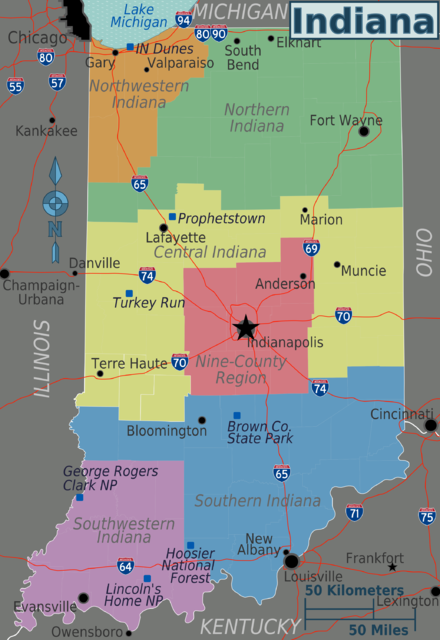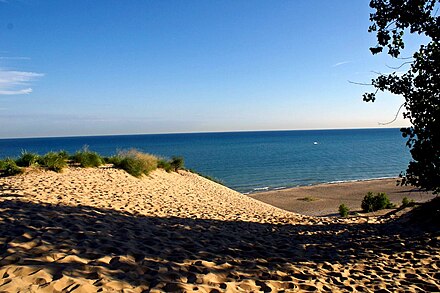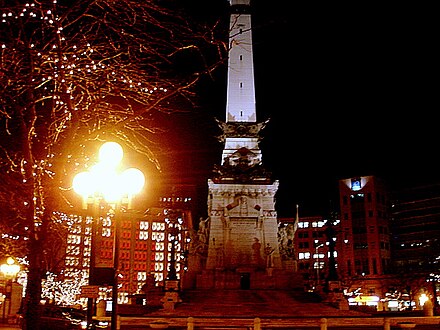Indiana - state of the United States of America
Indiana is a state in the heart of the Midwest region of the United States. Indiana is more than a fly-over state with one large metropolitan area, rural farmland, and cozy college towns.
Regions

A crescent in the center of the state surrounding the capital region, home to one of the nation's premier science and technology universities, Purdue
The largest in terms of population, dominated by Indianapolis. The majority of nightlife, shopping, and monuments are here.
The second city of Fort Wayne and Notre Dame campus South Bend.
The pristine Indiana Dunes on Lake Michigan bleed into the industrial Gary and further into Chicagoland.
Home of Indiana University in Bloomington, farmland, and the large Brown County State Park border Louisville
Hilly highlands and caves, on the border with Kentucky. Includes Evansville and Lincoln's boyhood home.
Cities
- Indianapolis 📍 – capital and largest city
- Bloomington 📍 – bohemian college town housing Indiana University
- Evansville 📍 – quiet and quaint location of University of Evansville and University of Southern Indiana
- Fort Wayne 📍 – a mix of metropolitan and small town
- Gary 📍 – an industrial town in Chicagoland which has been rebuilding in the 21st century
- Muncie 📍 – notorious party town with Ball State University
- South Bend 📍 – contains the most beautiful college campus in the state: the University of Notre Dame
- Terre Haute 📍 – location of several colleges (including Indiana State University)
- West Lafayette 📍 – Purdue University and a well-preserved historic downtown district
Other destinations
- George Rogers Clark National Historical Park 📍
- Indiana Dunes National Park 📍
- John Mellencamp's Mansion 📍 – in the small town that song was about
- Lincoln Boyhood National Memorial 📍
Understand
.jpg/440px-Prophetstown_State_Park_-_Farm_(2659014649).jpg)
History
Geography & climate
Indiana is mostly rural with high population concentrations in a few major cities/towns. The majority of Indiana is open farmland, though this is changing with expansion.
Time zone
Most of Indiana is in the Eastern Time Zone (same as New York and Washington DC). However, far northwestern Indiana is the Central Time Zone, so it has the same time as nearby Chicago. Likewise, for southwestern Indiana, which includes Evansville. Both zones observe daylight savings from early March to early November.
Talk
While English is the common language, there regions of Indiana where the Amish live who also speak Pennsylvania Dutch, which is related to German.
Get in
By plane
Indianapolis International Airport (IATA: IND) is the major airport in the state with flights to many cities around the country. Direct international service to IND is limited, and includes a daily Air Canada flight to Toronto and, since 2018, Delta flight to Paris.
Small airports in Fort Wayne, Evansville and South Bend offer flights to nearby hub cities. Air service is also available from airports in neighboring states, in Chicago, Cincinnati and Louisville.
By car
Numerous interstate highways enter and leave the state. Interstates 80 and 90 form the Indiana Toll Road in northern Indiana, linking Gary, South Bend and Ohio. Interstate 94 hugs most of Lake Michigan from Illinois to Michigan. Interstate 65 is the major north-south route from Gary south to Indianapolis then entering Kentucky at Louisville. Interstate 70 is the busiest east-west route linking Illinois (at Terre Haute) with Ohio (at Richmond), passing through Indianapolis midway. Interstate 74 does the same thing, except it enters near Danville, Illinois and leaves near Cincinnati. Interstate 64 crosses southern Indiana from Illinois (25 miles northwest of Evansville) to New Albany. Interstate 69 runs from northeast Indiana, out of Michigan, through Fort Wayne and Indianapolis to Evansville, with a gap between Indianapolis and Bloomington that is under construction. Interstate 275 (the Cincinnati bypass) briefly enters Indiana for about five miles. US 41 extends from Gary to Evansville and is the major north-south route through western Indiana.
By train
Amtrak's Cardinal provides service between Chicago and New York City via Indianapolis. The Capitol Limited and Lake Shore Limited serve South Bend and a few other stops along Indiana's northern border.
By bus
Greyhound and Miller Trailways serve Indianapolis and most of other major cities of Indiana, on a very basic schedule. Megabus runs between Chicago, Indianapolis, and Cincinnati, Louisville, and other cities to the south.
By foot
- The American Discovery Trail connects Indiana with Illinois, Kentucky, Ohio and both coasts.
Get around
Indiana's motto is "The Crossroads of America" and it is deserving. Indiana has more Interstates (14) than any other state its size, although the original name comes from all the railroad tracks that went through the state.
By train
- Amtrak offers a daily train service from Indianapolis to Chicago and vice versa. The fare is reasonable (about $15–25 each way). The train also passes through Lafayette as well as a few other towns along its way to Chicago. The time of travel is roughly about 4½ hours compared to about 3–3½ hours by car.
- South Shore Line links Northern Indiana to Chicago, stopping at Hammond, East Chicago, Gary, Ogden Dunes, Beverly Shore, Michigan City, Hudson Lake and South Bend. It terminates at Chicago's Millennium Station. The overall travel time from South Bend to Chicago (and vice versa) 2½ hours. The line utilizes a zone-based fare system, with prices rising based on the distance, and the prices drop slightly on the weekends. The prices range from $3.80–10.75 on weekdays and $3.00–9.00 on weekends.'
By bus
- Besides Greyhound, Miller Trailways (aka Hoosier Ride) operates intercity bus service throughout Indiana.
- Several shuttle bus companies connect Indianapolis Airport with other cities in central Indiana (Terre Haute, Bloomington, West Lafayette, Muncie), making the airport a hub of ground transportation of sorts as well; some of them also have occasional bus service on non-airport routes (to Chicago, shopping malls, etc). GoExpress also runs regular shuttle service between Bloomington and downtown Indianapolis/IUPUI (Campus Commute).
- Information on transit can be found here.
By hitchhiking
- Hitchhiking is legal in Indiana, except on the interstate freeways.
See
Your traditional sightseeing in Indiana belongs in Indianapolis, which is flush with big museums, an inordinate quantity of giant monuments and memorials, and a very nice canal walk with paddleboats and public art.
Outside the cities, and outside of the seemingly endless farmland in the plains, are a host of parks and outdoor recreation areas worth visiting. Without a doubt, the one to see, if you must choose, is Indiana Dunes National Park (and Indiana Dunes State Park). The dunes are enormous, the water crystal clear, the swampy forests beautiful, and the far-off industrial views intriguing.
A total solar eclipse on Monday 8 April 2024 crosses the State shortly after 3PM. The track of totality is northeast from Mexico and Texas to Illinois, then across Indiana (through Indianapolis but missing Fort Wayne) to Ohio and the Canada–New England border.
Do
State parks
- Brown County State Park
- Chain O' Lakes State Park
- Charlestown State Park
- Clifty Falls State Park
- Prophetstown State Park
- Turkey Run State Park
Festivals and events
- Late April Thunder Over Louisville Clarksville and Jeffersonville. The opening ceremonies to Louisville, Kentucky's Kentucky Derby Festival. Thunder Over Louisville is the largest annual fireworks show in the country, and the best viewing is along the Indiana shore of the Ohio River. If you plan to get a good seat, prepare to come the day before and camp. In the afternoon, private and military aircraft provide a magnificent airshow. After sunset, the fireworks begin and last nearly half an hour.
- Early-Mid August Indiana State Fair State Fairgrounds, Indianapolis. The biggest summer event in the state. A trip to Indiana isn't complete without a trip to the fair. Animals, crafts, art, rides, dancing, education, environmentalism, Hoosier Pride and food. They also have live music and concerts. Prairie Home Companion comes every other year.
- Early September Valparaiso Popcorn Festival Downtown Valparaiso, Valparaiso. Named the "Best Festival of the Region" by The Times readers for 15 years, the Valparaiso Popcorn Festival continues to offer family-fun activities for all ages. Over 200 arts & crafts booths, 30 food booths, kids' games, the five-mile Popcorn Panic, and the nation's First Popcorn Parade are only the beginning of the excitement of this incredible festival.
- Mid-September Lanesville Heritage Weekend Lanesville. A fall festival typical of many in southern Indiana. It is similar to a county fair, but later in the year. Local food and crafts are available, while rides and tractor and truck pulls provide entertainment.
- Early October West Side Nut Club Fall Festival Evansville. Called the second largest street festival in the United States after Mardi Gras. It takes place on several blocks of Franklin Street on the west side of the city during the first full week of October. The main attraction of the festival is its food booths which sell a large variety of foods including brain sandwiches and chocolate-covered grasshoppers. The festival draws over a hundred thousand visitors every fall.
- Early-mid October Harvest Homecoming Festival New Albany. The largest festival in southern Indiana brings participants from miles around. The festivities begin with a Saturday morning parade through the streets of New Albany. The festival lasts for several weeks, and includes vendor booths downtown and carnival rides.
- Mid October Feast of the Hunters' Moon Lafayette. The Feast re-creates early 18th-century life near the site of Fort Ouiatenon, a French trading outpost.
Sports

- College sports- Indiana is home to many Division I NCAA schools:
- Ball State University (Muncie)
- Butler University and IUPUI (Indianapolis)
- University of Evansville (Evansville)
- Indiana University (Bloomington)
- Indiana State University (Terre Haute)
- University of Notre Dame (South Bend)
- Purdue University (West Lafayette)
- Purdue University Fort Wayne
- Valparaiso University (Valparaiso)
- Baseball- Indiana is home to a number of minor league baseball teams, including: Gary SouthShore RailCats, Fort Wayne TinCaps, Indianapolis Indians, South Bend Blue Sox, South Bend Silver Hawks, and Evansville Otters.
- Racing- The Indianapolis 500 race is the most attended sporting event in the world. It's common to see many vendors and spectacular displays during the pre-race (most notably the singing of "Back Home Again In Indiana", formerly by the now-deceased Jim Nabors, and the overfly of the stealth bomber at the conclusion of the National Anthem). Also don't forget the Allstate 400 (formerly the Brickyard 400) NASCAR race held every summer in Indianapolis. IRP (Indianapolis Raceway Park) also holds the grand nationals of drag racing at its facility. IRP is located about 10 miles west north-west of Indianapolis in Hendricks County
- Racing- Salem Speedway. Home to many small-circuit races throughout the year, Salem is often called the "fastest half mile in the world." With only a chain-link fence separating the pit lane from the infield, Salem offers a more interactive fan experience than many larger tracks.
Eat
Cuisine throughout much of the state is typical Midwestern, with the occasional odd dish like Corn Casserole. Outside of the main cities most of the restaurants are diners or family-style, while in the bigger cities you can find all sorts of varied cuisine. Indianapolis, in particular, has a very cosmopolitan selection of ethnic restaurants from around the world, as do major campus towns (Bloomington, West Lafayette). Lake County, as in most everything, diverges from the norm in Indiana, and is a better place to find Chicago-style food like hot dogs and pizza.
Drink
Hoosiers know how to drink! Wherever you are, you would be hard pressed to not find a bar. The trendiest part of the state for a drink is probably Broad Ripple in Indianapolis, but you will find streets packed with bars and pubs throughout the cities of the state, especially near major universities in Bloomington, West Lafayette, and South Bend. Micro-breweries are present in all the major cities, Upland from Bloomington is especially popular and available throughout the state. Drink prices can be very low in Indiana—especially out of the Nine-County Region. It's not uncommon to find domestic bottled beer for $1 during the week, with other varying specials.
For dancing and nightlife, the main options are in and around Indianapolis and Fort Wayne, as well as by the major universities.
Liquor stores are open on Sundays throughout the state. Hours are noon to 8PM.
Bars and restaurants are allowed to serve beer, wine, and liquor seven days a week, between the hours of 7AM and 3AM (the following morning), local time. Hours for bars can vary by population density and owner preference, but the vast majority of full-service "chain" restaurants with alcohol sales will not remain open beyond 11PM or midnight. In most localities however, one can always find a neighborhood bar or nightclub that will serve drinks right up to 3AM. In all substantial cities, almost all bars will remain open until this time.
There have been many rumors about a liquor law in Indiana that prohibits the "take home" sale of cold beer. This is absolutely false. Throughout the state in any liquor store, Village Pantry service stations, and some grocery stores it can be purchased cold. Liquor stores that sell hard alcohol cannot sell pop or soda cold, rather it must be at room temperature.
Stay safe
Largely rural, Indiana has a fairly low crime rate per capita. In 2006 (the latest year for which data is available) it ranked 29th in crimes per 100,000 population. Large urban areas are exceptions like the former steel town Gary and the outlying Chicago area in the Northwest and certain segments of Indianapolis.
While outside of Tornado Alley, Indiana has a fairly high occurrence of tornados. You might want to check the Tornado safety page if you are visiting Indiana.
High incidence of HIV and hepatitis C infection were reported in 2015 in certain areas of southeastern Indiana, centered on the town of Austin in Scott County. (See official press releases here: HIV outbreak in southeastern Indiana.)
Connect
The vast majority of Indiana is on Eastern Time and observes Daylight Savings Time in 2006. The five counties of Northwestern Indiana (near Chicago) and several counties around Evansville are on Central Time.
Go next
- Illinois – Chicago, the largest city in the Midwest, is just across Indiana's western border, making it an ideal day-trip destination.
- Kentucky – Indiana's neighbor to the south is known for its rolling hills, horses, and rural inhabitants, offering travelers a less-visited but tremendously beautiful destination.
- Ohio – Located to the east of Indiana, the city of Cincinnati is a short drive from southeastern Indiana.
- Michigan – Indiana's northern neighbor borders four of the five Great Lakes and features stunning natural beauty.
Indiana
in.govUnited States
usa.govPopulation:327.2 MDial code:+1Currency:Dollar (USD)Voltage:120 V, 240 V, 60 HzNEMA 14-30NEMA 14-50
